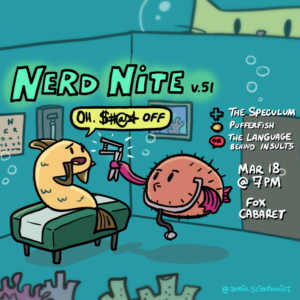Have you ever heard a phrase and wondered – where the heck did that come from? What’s the history behind this? For example, have you been telling people they’re a “shoo-in” thinking it’s referring to shoes? Nerd Nite co-boss Kaylee certainly has. It turns out that this phrase actually originated from horse racing in the 1920s, where a horse was urged on to win by “shooing” it, often referring specifically to cases where a race was fixed so that all the horse needed to do was be waved across the finish line. Today, the term is used to refer to those who are well liked or destined to win, and we think we’ve got three shoo-in talks for you this coming March 18th! Join us to learn about the history of the speculum, the language behind insults. And round it all off with some beautiful images and fun facts about pufferfish!
Hosted by: Kaylee Byers and Michael Unger
When: Wednesday February 26th; Doors @ 7, show starts @ 7:30
Poster by: Armin Mortazavi
Music by: DJ Burger

1. The History of the Speculum
Jacqueline Seppelt
Most people who have visited a gynaecologist have met the vaginal speculum, the duck-billed medical instrument used to hold open the vagina during a pelvic exam. Today, the speculum is used to diagnose, treat, and take swabs from the cervix and vagina. Most individuals would agree that these medical examinations are pretty awkward and go on without any sexual tension. However, that wasn’t the case when the vaginal speculum was reintroduced to modern medicine during the 19th-century. The vaginal speculum has a dramatic history filled with sexual accusations and questionable professional integrity. This history continues to have implications on the people behind the vaginas it meets today.
Bio: Jacqueline is an undergraduate student pursuing her BA in Sociology at the University of British Columbia. Her research interests include sexuality, gender inequality, and women’s health. She also enjoys learning about the vagina, and applying her sociological lens to the social issues surrounding reproductive and sexual health. Jacqueline is by no means an expert on the vaginal speculum, but she worked very hard on a research paper about it and would like to share it with the world outside of academia.
2. The Fascinating world of… Pufferfish
Amy Liu
The pufferfish might be considered an overlooked fish… But watch out- the pufferfish can inflate up to three times their size and is considered the second most poisonous vertebrate on Earth, and yet, its flesh is considered a delicacy in certain parts of the world. Here’s a lesser known fact: Pufferfish are very curious and intelligent. They can be taught tricks, learn to memorize different shapes and patterns, and recognize their owners. They have also made their names both in culture and science, from ingredients in the infamous Haitian Zombie Powder to being the first vertebrate to have their whole genomes sequenced (Completed 4 years before humans!). Their relatives include the great Mola mola, the spiny porcupinefish, and the interestingly shaped boxfish. Learning about the fascinating world of Pufferfish helps understand the diversity of these amazing animals, and the challenges they are facing.
Bio: Amy Liu (she/they) is a self-proclaimed pufferfish (family Tetraodontiformes) enthusiast, and a masters student studying fish genetics at The University of British Columbia. Always drawn to the fascinating fishy science, Amy has worked closely with both fish and people at the Vancouver Aquarium, Royal Tyrrell Museum of Paleontology, Parks Canada, and local aquarium stores. If there was a happy place on earth for them, it would be going back to snorkel in Belize, happily swimming with the puffers in the blue ocean.
3. F*ckpuffins and sh*tgibbons: the secret life of new swearwords
Anne-Michelle Tessier
By the time you’re an adult, you’ve had decades of experience with your native language’s words and sound patterns, and you can use that amazingly fine-tuned linguistic experience to perform advanced tasks like inventing new obscene insults for your least favorite people on the internet. As it turns out, English-speaking people have fairly consistent intuitions about which swear words sounds best — but those intuitions rely on our unconscious knowledge of English, and they come from a variety of cognitive sources and biases. What are those sources and biases? Where do they come from? And why is it so satisfying to call someone a sh*tgibbon? … The science of linguistics has answers, and there’s a lot of terrific obscenity along the way.
Bio: Anne-Michelle Tessier just joined the UBC Linguistics faculty in 2019. She received her BA from McGill University and her Ph.D. from UMass Amherst; she has also held professorships at the University of Alberta, the University of Michigan and Simon Fraser. Most of her work focuses on how children learn to sound like native speakers of their language(s) — e.g. why they sometimes say ‘lellow pitchiks’ instead of ‘yellow pictures’ — but sh*tgibbons are one of her favorite professional hobbies.
